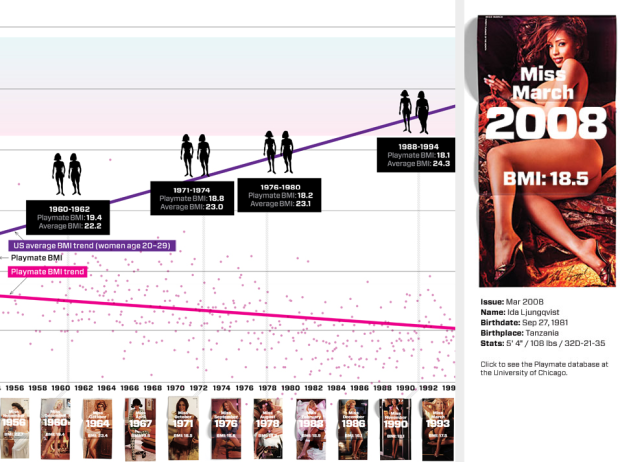Playboy playmates continue to be a point of fascination. Remember that study on Playmates and the state of the economy? Anyhow, Wired Magazine visualizes Playmate BMI and US average BMI over the years. While the US average BMI shows an increasing trend, Playmate BMI shows a decreasing trend. Yikes.
The graph, however, is a little misleading. The decreasing trend isn’t especially significant-looking from 1976 on, but then again, that’s just me going off a tilted head glance. If anyone wants to figure out the actual trend (please), the data is available on the Wired page. In any case, it’s amusing.
[Thanks, Ken]



Body mass index (BMI) is a measure of body fat based on height and weight that applies to both adult men and women.
Now that you mention it, the trend looks like it starts near the “normal” women at the beginning, is steeper than shown until the mid 70s, then flat. (Well, not “flat” if you know what I mean, but horizontal. Oh no, double entendres aboud.)
What’s the name of that analysis? LOESS? Which is kinda like a moving regression.
Yeah, if someone did a loess, I think the trend line might tell a different story.
A quick view from doing an XY plot in XL and then fitting trend lines you can get a couple different weak stories. A linear regression shows a decreasing BMI (r2=0.15), while a polynomial has an r2=0.24 and shows BMI on an upward slope after “bottoming” out in 1992.
I found a LOESS analysis someone had written for Excel, and I fixed it up and put some UI on it. Then I ran the data, and the chart is posted here:
http://peltiertech.com/images/2009-02/playmate_loess.png
(Nathan – feel free to download and insert the image itself instead of the link.)
There are basically three regimes in the data. From 1953 through 1963 or so, the BMI was about constant at 19.5. The BMI dropped slowly from the mid 1960s (19.4) through the mid 1970s (18.6), then a little more quickly through the mid 1980s. From this minimum of about 17.9, it has risen slowly to its current level of about 18.3. Perhaps over the past five years it has been about constant.
The Loess tool is pretty slick, I must admit. It has two range selection boxes, one for the actual (input) data, one for output data, and it lets you set the number of points in the moving regression. I kept it simple with a first-order regression. It’s much faster than I’d expected. After I add some validation and other niceties, I’ll offer it on my blog with a little write-up.
Wired’s infoporn page editor here.
That three-regime version is interesting–I generated the two-regime polynomial with the bottoming-out in 1992 that Bret describes, but figured that the downward trend at the tail-end of the dataset warranted us publishing the linear. Think I blew it?
By the way, if you think the double-entendres here are rough, you should have heard us talking about this piece in the office. For example, we call something that covers two full pages as this infographic does a “spread.” The joke is left as an exercise for the student.
Jon Peltier, let me know what you come up with after running the Loess. I’d love to see it.
Hello. I’ve created a graph which shows the full data plus a 24 month average, this shows that there hasn’t been a linear decrease, but it has actually risen slightly since the mid eighties. Great blog.
@Adam – That’s is one of the best job titles ever. Thanks for visiting FD and taking the time to comment :)
From an analytical standpoint, I’d say the linear fit is a bit of a stretch since there’s even a slight increase in BMI towards the end. So instead of a continuous decrease, we might even be seeing the beginning of an upswing in Playmate BMI. Julian’s moving average graph and Jon’s loess graph seem to suggest that.
A question: What is the selection process behind who is the playmate? If Mr. Hefner is judge judy, and executioner, this chart will potentially just show his taste in women over the years. Is it a team of editors or just Hugh? Anyone a religious watcher of “Girl next door”?
I’m sure the Hef has a lot of say on who is a playmate, but I bet he leaves a lot of the choices to Playboy editors. Either way though, it’s best to keep in mind that Playboy is a magazine – a business – so whoever is choosing intends to pick what will sell the most magazines.
My wife really likes Girls Next Door, so I’ve seen an episode or 20 :)
Pingback: dasistdasen.de » Linkmüllhalde für den 18. Februar ‘09
Pingback: Playboy pour la science | Karizmatic
Pingback: LOESS Smoothing in Excel | PTS Blog
Here’s a follow-up to my comment about a LOESS smoothing of the data:
LOESS Smoothing in Excel
Pingback: LOESS smoothing « Learning R
Pingback: Your Writing Dept Blog » InfoPorn: Presenting raw data with visually stimulating graphs